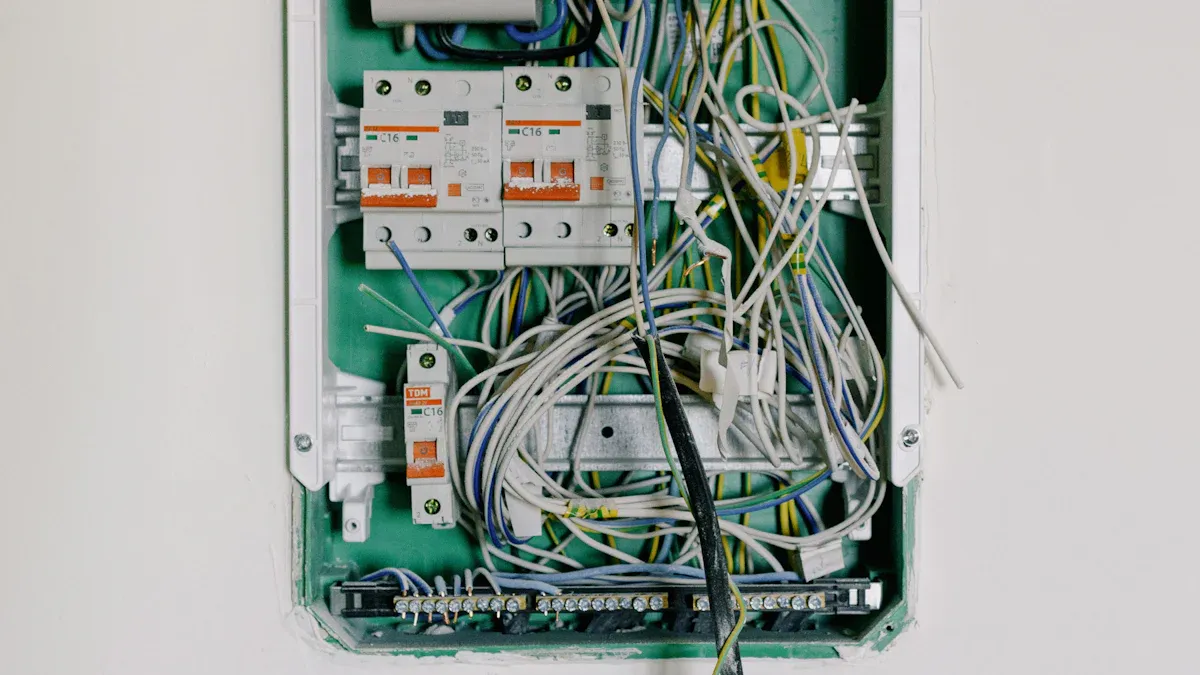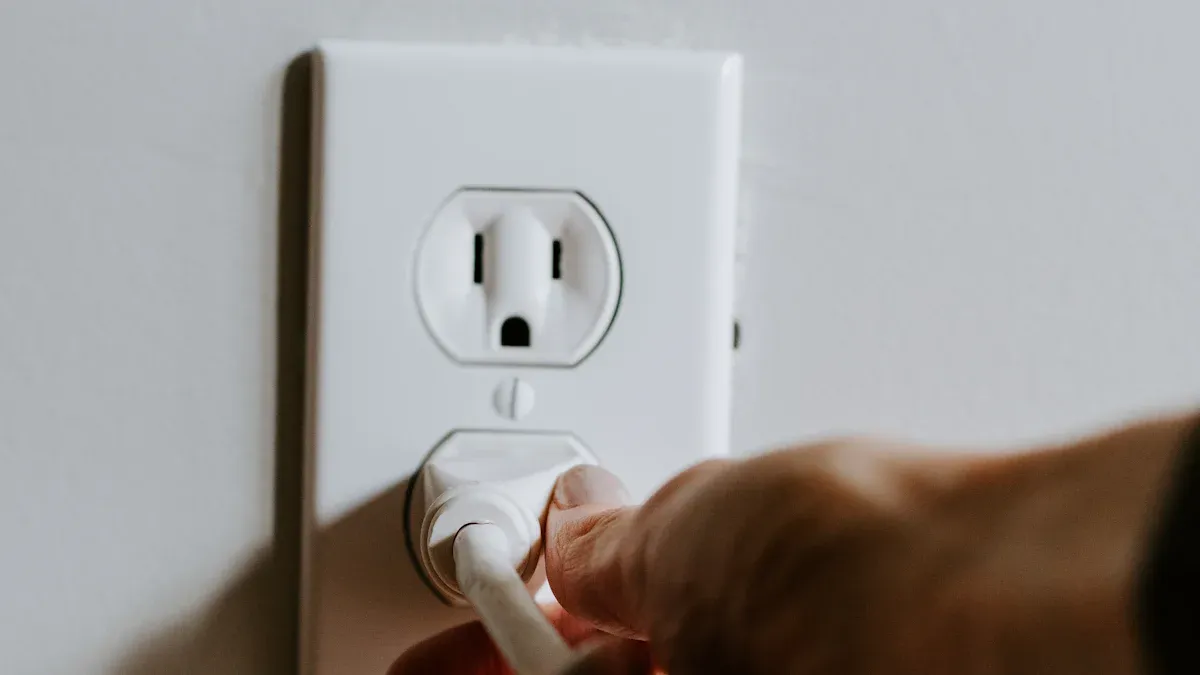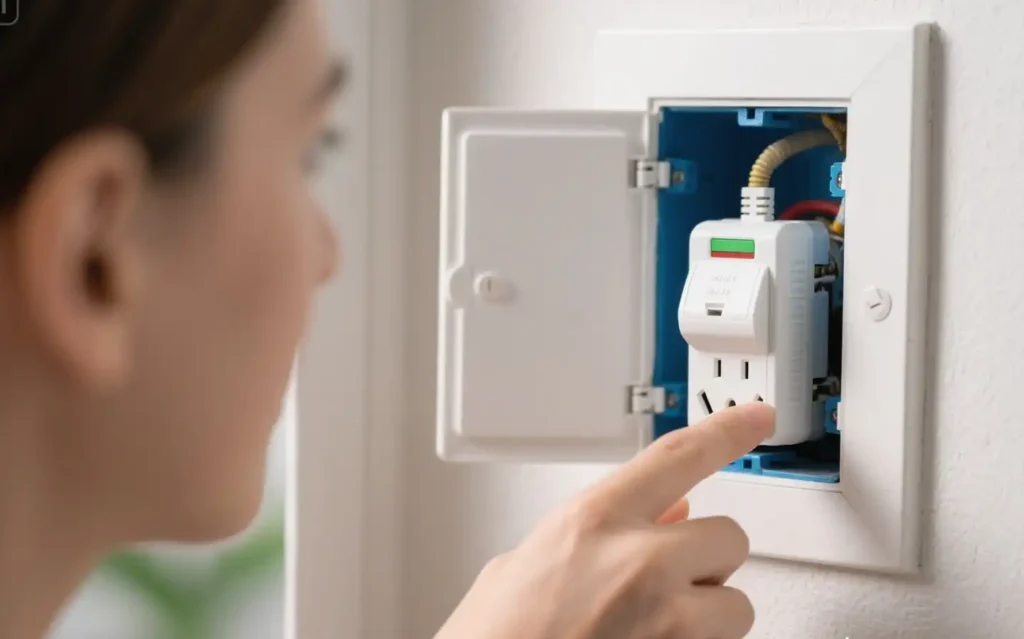The location of installing surge protectors is crucial. It helps keep your electronics safe from power surges. If you place them in the right spots, they can prevent expensive damage to items like computers, fridges, and TVs. Power surges, also known as voltage spikes, occur suddenly. They can either damage your devices immediately or cause gradual wear over time. Experts indicate that most device failures stem from this slow deterioration. By ensuring the location of installing surge protectors is optimal, you can keep your devices safer and extend their lifespan.
Key Takeaways
-
Surge protectors keep your electronics safe from power surges. Placing them close to devices makes them work better.
-
Put surge protectors at the main electrical panel. This helps protect all your appliances from big voltage spikes.
-
Check surge protectors often and replace them when needed. This keeps them working well and protects your devices.
-
Don’t plug too many things into one outlet. Spread devices across outlets to stop overheating and keep surge protectors working.
-
Pick good-quality surge protectors with high ratings. They give better protection for your important electronics.
Why the Location of Installing Surge Protectors Matters

The Role of Surge Protectors in Preventing Damage
Surge protectors are your shield against power surges. They protect electronics by sending extra energy safely into the ground. Unlike power strips, surge protectors are made to handle sudden voltage spikes. They use parts like MOVs (metal oxide varistors) to absorb extra energy as heat. This keeps your devices safe from harm.
For instance, a surge protector once stopped a surge from damaging devices. This shows how they save you from costly repairs or replacements. Without surge protectors, your electronics face risks like slow damage or sudden failure.
|
Specification |
Description |
|---|---|
|
Joule Rating |
Shows how much energy the surge protector can handle before failing. Higher ratings mean better protection. |
|
Clamping Voltage |
The voltage level where the surge protector starts working. Lower levels mean better safety. |
|
Response Time |
How fast the surge protector reacts to a surge. Faster times mean better protection. |
Knowing these details helps you pick the best surge protector for your home. This ensures your devices stay safe.
How Placement Impacts Effectiveness
Where you put surge protectors matters for protecting electronics. Placing them near important appliances or the main panel gives better safety. For example, at Frenchman’s Creek, surge protectors near cameras and enclosures stopped lightning damage. This smart placement saved the equipment.
If surge protectors are far from devices, they work less effectively. Long distances let more voltage reach your electronics. Keeping surge protectors close to devices improves safety. It also lowers the risk of electrical fires caused by voltage spikes.
Common Mistakes in Surge Protector Installation
Installing surge protectors wrong can cause device damage or safety issues. A common mistake is skipping proper grounding. Grounding helps surge protectors send extra voltage away safely. Without it, your devices stay unprotected. Another mistake is not checking surge protectors over time. Parts like TVS (transient voltage suppressors) and GDT (gas discharge tubes) wear out. Worn-out parts can cause short circuits or fires.
In one case, a home without whole-house surge protection suffered major damage from a surge. This shows why installing surge protectors in key spots and checking them often is important. Avoiding these mistakes keeps your home and devices safe.
Best Locations for Surge Protector Installation

At the Main Electrical Panel for Whole-Home Surge Protectors
Putting a whole house surge protector at the main panel is smart. It stops big voltage spikes before they spread through your home’s wiring. This protects all your appliances and electronics from damage. For example, lightning once hit a utility pole, causing a surge. A homeowner lost $11,000 worth of appliances. A whole house surge protector could have avoided this loss.
These surge protectors handle surges from lightning and electrical problems. Installing them at the main panel lets them work effectively. This spot helps protect your entire home and all connected devices.
Tip: If you live in stormy places like Florida, this is vital. Frequent storms increase surge risks, making this protection necessary.
Near Essential Appliances Like HVAC Systems and Refrigerators
Place surge protectors near important appliances like HVAC systems and fridges. These items are costly and needed for daily comfort. Surge protectors block dangerous surges and send extra energy safely to the ground. Without them, you might face expensive repairs or replacements.
During storms, surge protectors near these appliances are helpful. They stop extra electricity and keep your HVAC and fridge safe. This ensures they work even in bad weather. You’ll feel secure knowing your key appliances are protected.
Note: Older homes with outdated wiring face higher surge risks. If your home is older, focus on protecting essential appliances first.
In High-Risk Areas Such as Home Offices and Entertainment Systems
Home offices and entertainment areas often have many electronics. Devices like computers, TVs, and gaming consoles are common here. Surges and electrical noise cause about half of electronic failures. Protecting these areas with surge protectors is very important.
Surge protectors in these spots reduce damage risks and prevent data loss. This is especially useful for home offices. Since most surges come from inside the building, placing surge protectors here improves safety for your devices.
Tip: Think about how valuable your electronics are in these areas. If you own expensive devices, buy high-quality surge protectors for better protection.
Practical Tips for Effective Surge Protector Installation
Keep Surge Protectors Close to Power Sources
Place surge protectors near power sources for better protection. If they are far from devices, extra voltage can harm electronics. Long wires allow more electricity to pass through, increasing risks. Shorter distances mean quicker response and safer appliances.
For example, putting surge protectors near your HVAC or TV area helps. It lowers the chance of voltage spikes or electrical noise damaging these devices. Close placement also makes surge protectors work more efficiently during sudden surges.
Placement Tip: Check your home’s electrical layout. Find spots where surge protectors can be installed close to power sources for the best safety.
Avoid Plugging Too Many Devices into One Outlet
Using one outlet for many devices can cause overheating or fires. Overloading circuits also reduces how well surge protectors work. This can damage both your electronics and the surge protector itself.
Spread your devices across different outlets and circuits to stay safe. Choose surge protectors with overload protection. These models turn off power if too much current is detected, keeping your home and devices safe.
Electrical Safety Tip: Look at your outlets often for damage or overheating. Replace broken outlets quickly to keep your surge protectors working properly.
Choose Reliable Surge Protectors with Good Ratings
Buy high-quality surge protectors for strong and dependable safety. Look for ones with good ratings and trusted certifications. Important features include how much energy they handle, how fast they react, and their build quality. Brands like Eaton and ONESTO are great for heavy surges, KSP-6-320 and Square D offer affordable and safe options.
|
Rating/Standard |
What It Means |
|---|---|
|
Shows the highest current the surge protector can handle during a short circuit. |
|
|
Modes of Protection |
Protects against normal (Phase to Phase, Phase to Neutral) and common (Phase to Ground, Neutral to Ground) surges. |
|
Safety Certifications |
Look for UL, CSA, or ETL certifications for trusted performance. |
New features like smart surge protection and self-healing technology add extra safety. These let you monitor remotely and fix small issues automatically, keeping your devices safe even during minor surges.
Placement Tip: Match your surge protector’s features to your needs. This ensures your home and electronics stay fully protected.
Seek Professional Help for Whole-Home Surge Protectors
Hiring experts to install whole-home surge protectors ensures they work well. Professionals follow strict rules like IEC 61643-11 for AC systems and UL 1449 for AC and DC systems. These rules make sure surge protectors are safe and effective. Below is a table showing key standards used by professionals:
|
Standard |
Use Type |
|---|---|
|
IEC 61643-11 |
AC Power Systems |
|
IEC 61643-32 |
DC Power Systems |
|
IEC 61643-21 |
Data and Signals |
|
UL 1449 |
AC and DC Power Systems |
|
UL 497B |
Data and Signals |
Experts also check grounding, which helps surge protectors work properly. Bad grounding can make surge protectors useless, leaving your home unprotected. Professionals also inspect your home’s wiring to find risks and suggest the best surge protectors.
Tip: If storms or power changes happen often where you live, hiring a professional is even more important. It keeps your home safer and gives you peace of mind.
Check and Replace Surge Protectors Often
Surge protectors wear out after stopping many surges. Regular checks help spot damage so your devices stay safe. Some companies offer replacements if surge protectors fail while protecting your electronics. This shows why keeping surge protectors in good shape matters.
Checking surge protectors also helps your home’s wiring last longer. Inspections can find old or broken surge protectors before they cause issues. Experts suggest yearly checks by trained technicians to make sure surge protectors work well. Here’s a table with expert advice:
|
Source |
Advice |
|---|---|
|
Emergency Electricians Checklist |
Inspect and maintain systems regularly. |
|
AC Direct |
Have a technician check surge protectors yearly. |
|
Call Hoover |
Look for bad wiring and keep systems ready. |
|
Fix My Home |
Use whole-home surge protection for better safety. |
Replace surge protectors if they look damaged or are too old. Doing this lowers the chance of device failure and keeps your electronics safe.
Note: Surge protectors with lights make it easy to check their status. Replace them if the light goes out or if the protector looks damaged.
Where you place surge protectors in your home matters a lot. Putting them near the main electrical panel or important appliances gives better protection. More people own electronics now, with a 20% rise recently. Weather disasters have also grown five times in 50 years. This makes surge protection more important than ever. Check your setup today. Adjust it to keep your home and devices safe from sudden power surges.
Reminder: Check your surge protectors often. Replace them if they stop working.
FAQ
What makes a surge protector different from a power strip?
A surge protector keeps your devices safe from voltage spikes. A power strip only gives extra outlets and doesn’t protect against surges. Surge protectors have parts like MOVs to handle extra energy. Power strips don’t, so your electronics stay at risk.
Tip: Look for a joule rating to ensure it’s a surge protector.
How long do surge protectors last?
Replace surge protectors every 3-5 years or after big surges. Their parts wear out over time, making them less effective. Some have lights that show when they stop working.
Reminder: If the light is off, replace the surge protector.
Can high-power appliances use surge protectors?
Yes, but pick surge protectors made for high-power devices. Choose ones with high joule ratings and overload protection. These features keep appliances like fridges and HVAC systems safe.
Note: Don’t plug many high-power devices into one surge protector.
Do surge protectors help during power outages?
Surge protectors don’t stop outages but protect when power returns. Voltage spikes happen when electricity comes back. Surge protectors absorb this energy to protect your devices.
Tip: Use surge protectors with a UPS for extra safety.
Are whole-home surge protectors a good idea?
Whole-home surge protectors protect all devices in your house. They block surges at the main panel, keeping everything safe. This is helpful in areas with lightning or frequent power changes.
Advice: Hire a professional to install them for the best results.
The following information may be of interest to you
How to Replace a Surge Protector Safely and Efficiently
What You Need to Know About Surge Protection Device Lifespan
How to Test Surge Protection Devices for Optimal Performance
What are the warning signs of surge protector failure



